AQS之独占锁实现原理
一:AQS概念
AQS是java.util.concurrent包的一个同步器,它实现了锁的基本抽象功能,支持独占锁与共享锁两张方式,
独占锁:同一时刻只允许一个线程方法加锁资源,例如:ReentrantLock
共享锁:同一时刻允许多个线程方法资源,例如:countDownLatch
二:数据结构
AQS 队列内部维护的是一个 FIFO 的双向链表,这种结构的特点是每个数据结构都有两个指针,分别指向直接的后继节点和直接前驱节点。所以双向链表可以从任
ReentrantLock lock = new ReentrantLock();
lock.lock();
try {
System.out.println("do something......");
} finally {
lock.unlock();
}
看一下new ReentrantLock()
默认创建了一个非公平锁,ReentrantLock内部维护了一个Sync同步器,
public ReentrantLock() {
sync = new NonfairSync();
}

看一下lock方法:

首先是比较状态,同步器类AbstractQueuedSynchronizer维护了一个同步状态的字段
private volatile int state;
当状态为0时,表示资源没有被占用,大于0则表示被占用
来一个线程首先判断当前状态是否是0,如果是则把state设置为1,然后把当前线程设置为资源拥有者
static final class NonfairSync extends Sync {
private static final long serialVersionUID = 7316153563782823691L;
/**
* Performs lock. Try immediate barge, backing up to normal
* acquire on failure.
*/
final void lock() {
if (compareAndSetState(0, 1))
setExclusiveOwnerThread(Thread.currentThread());
else
acquire(1);
}
protected final boolean tryAcquire(int acquires) {
return nonfairTryAcquire(acquires);
}
}

这里的acquire都是同步器实现的:


如果当前的状态是0,则说明此时没有线程占用锁,那么设置同步器状态,并把当前线程设置为资源拥有者
如果当前状态不是0,则判断当前线程是否是资源拥有者(因为支持可重入,所以可能大于0),如果是则累加状态值
如果不是则返回失败
final boolean nonfairTryAcquire(int acquires) {
final Thread current = Thread.currentThread();
int c = getState();
if (c == 0) {
if (compareAndSetState(0, acquires)) {
setExclusiveOwnerThread(current);
return true;
}
}
else if (current == getExclusiveOwnerThread()) {
int nextc = c + acquires;
if (nextc < 0) // overflow
throw new Error("Maximum lock count exceeded");
setState(nextc);
return true;
}
return false;
}
如果获取锁失败,则入队列

先看一下addWaiter方法:
CLH队列底层维护的是一个双向链表结构,每一个节点Node维护当前线程引用,前一个节点和后一个节点的引用,Node节点
还具有状态
static final class Node {
static final Node SHARED = new Node();
static final Node EXCLUSIVE = null;
static final int CANCELLED = 1;
static final int SIGNAL = -1;
static final int CONDITION = -2;
static final int PROPAGATE = -3;
volatile int waitStatus;
volatile Node prev;
volatile Node next;
volatile Thread thread;
Node nextWaiter;
final boolean isShared() {
return nextWaiter == SHARED;
}
final Node predecessor() throws NullPointerException {
Node p = prev;
if (p == null)
throw new NullPointerException();
else
return p;
}
Node() { // Used to establish initial head or SHARED marker
}
Node(Thread thread, Node mode) { // Used by addWaiter
this.nextWaiter = mode;
this.thread = thread;
}
Node(Thread thread, int waitStatus) { // Used by Condition
this.waitStatus = waitStatus;
this.thread = thread;
}
}
看一下addWaiter方法:
第一次进来tail为null,所以会调用enq这个方法:
private Node addWaiter(Node mode) {
Node node = new Node(Thread.currentThread(), mode);
// Try the fast path of enq; backup to full enq on failure
Node pred = tail;
if (pred != null) {
node.prev = pred;
if (compareAndSetTail(pred, node)) {
pred.next = node;
return node;
}
}
enq(node);
return node;
}
来看一下enq方法:
如果tail为null,则新建一个node节点,并设置为head,然后将head引用赋值给tail,这样head和tail都指向一个空节点Node
private Node enq(final Node node) {
for (;;) {
Node t = tail;
if (t == null) { // Must initialize
if (compareAndSetHead(new Node()))
tail = head;
} else {
node.prev = t;
if (compareAndSetTail(t, node)) {
t.next = node;
return t;
}
}
}
}

初始化完成,新加进来的Node会被设置为tail尾部节点,然后之前最后一个节点建立pre、next连接
下面框里tail不为null,就不是第一个被放进来的node节点,直接把node设置到tail尾部。
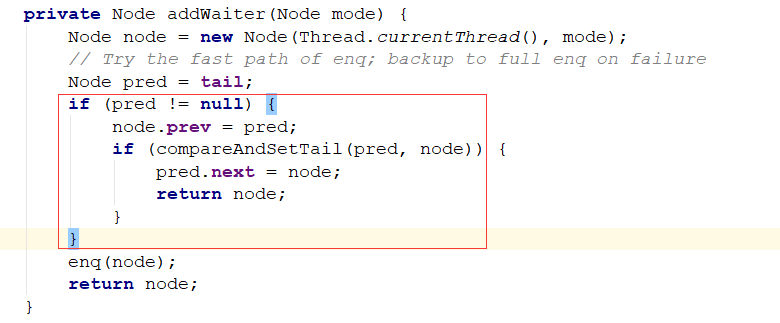
看一下获取对列方法acquireQueued:
前面已经将获取锁失败的线程以node节点的形式放到了CLH对列的tail尾部,这里的node就是维护当前线程的node,
如果node的前驱节点为head(head为正在执行的线程的节点),那么会再次尝试获取锁。
获取锁成功:把让对列的head指向node,然后将node节点维护的前驱和线程置位null,在这里拿到锁,其实并不需要前驱节点的线程唤醒,
因为当前线程并没有阻塞。
获取锁失败:如果前驱节点不是head或者是head获取锁失败,那么就会park当前线程。
final boolean acquireQueued(final Node node, int arg) {
boolean failed = true;
try {
boolean interrupted = false;
for (;;) {
final Node p = node.predecessor();
if (p == head && tryAcquire(arg)) {
setHead(node);
p.next = null; // help GC
failed = false;
return interrupted;
}
if (shouldParkAfterFailedAcquire(p, node) &&
parkAndCheckInterrupt())
interrupted = true;
}
} finally {
if (failed)
cancelAcquire(node);
}
}

看一下shouldParkAfterFailedAcquire:
如果前驱节点的状态为signal,则可以安全的park阻塞当前线程,因为前驱为signal状态,说明当前驱节点维护的线程释放锁后,会通知当前线程。
如果状态大于0,就是已取消,则向前遍历,直到找到一个未取消的,已取消状态,可能该任务已经中断或者超时。
如果不是signal状态,也没有取消,那么就把前驱节点的waitStatus设置为signal,然后该节点就可以安全的park了。
private static boolean shouldParkAfterFailedAcquire(Node pred, Node node) {
int ws = pred.waitStatus;
if (ws == Node.SIGNAL)
/*
* This node has already set status asking a release
* to signal it, so it can safely park.
*/
return true;
if (ws > 0) {
/*
* Predecessor was cancelled. Skip over predecessors and
* indicate retry.
*/
do {
node.prev = pred = pred.prev;
} while (pred.waitStatus > 0);
pred.next = node;
} else {
/*
* waitStatus must be 0 or PROPAGATE. Indicate that we
* need a signal, but don't park yet. Caller will need to
* retry to make sure it cannot acquire before parking.
*/
compareAndSetWaitStatus(pred, ws, Node.SIGNAL);
}
return false;
}

这里很简单,就是把当前线程park阻塞。然后当前线程就会在这里阻塞,直到被前驱节点的线程唤醒。
private final boolean parkAndCheckInterrupt() {
LockSupport.park(this);
return Thread.interrupted();
}
如果此时前一个线程执行完毕,执行unpark,那么该线程就会被唤醒。
唤醒之后,又会进入for死循环,争抢锁资源(因为是非公平锁),获取到锁则执行代码,获取不到,还会执行
到park方法阻塞,如果该线程在阻塞过程中被中断,那么唤醒后会执行中断方法。
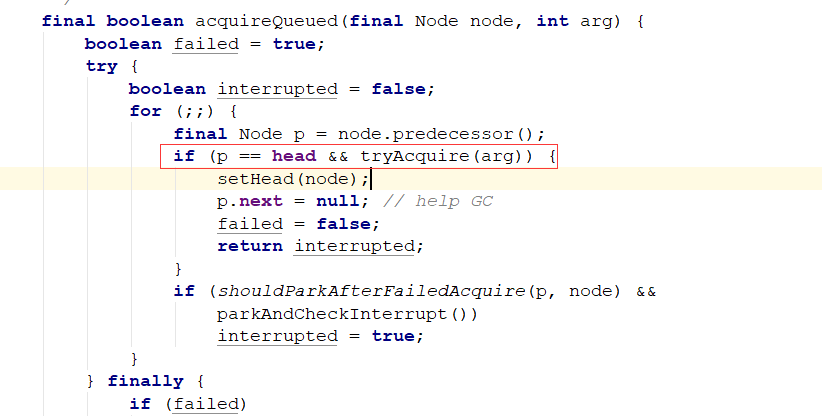
上面是非公平锁的实现,下面来看一下公平锁的实现,公平锁的实现应该更简单一些,
就是获取锁失败后,直接进入对列等待,不会在获取锁,进入对列的时候获取锁,非公平锁,在阻塞之前
有三次获取锁的机会。
ReentrantLock的构造方法是有参数,可以设置是否采用公平锁:


看lock方法:


公平锁与非公平锁的区别:
非公平锁获取失败后,会再次尝试获取,而公平锁直接获取。
公平锁:

非公平锁:

如果当前状态为0,当前没有线程占有锁,它会先判断对列中是否有前驱节点,如果有则不会获取锁,然后进入对列中
等待。
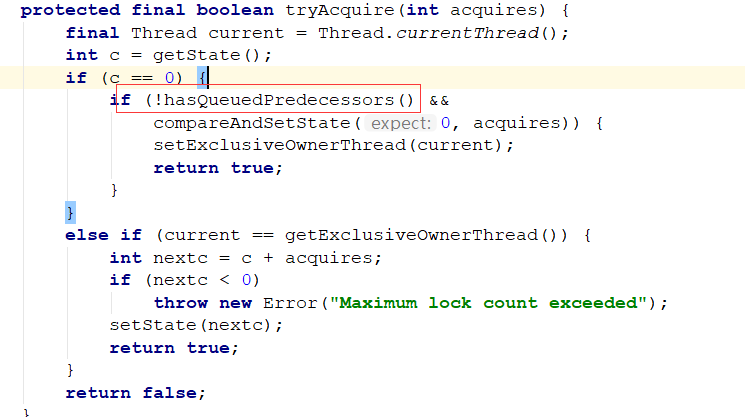
锁的释放:

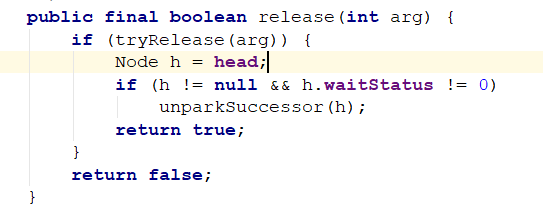
如果线程的状态为0,则把排他线程设置为null,如果重入次数过多,那么就需要多次unlock才可以,到最后一次unlock才会
释放锁
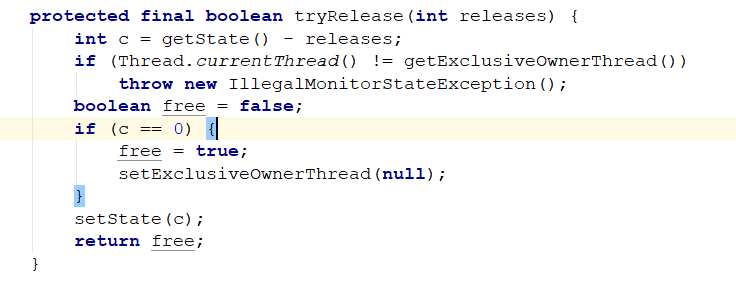
唤醒下一个线程:
unparkSuccessor(h);
把head节点设置为0状态,然后下一个节点不为null,则唤醒下一个节点,如果为null,
则从tail往前遍历,找到node下面不能为null且最近的没有被取消的节点,然后唤醒。
private void unparkSuccessor(Node node) {
/*
* If status is negative (i.e., possibly needing signal) try
* to clear in anticipation of signalling. It is OK if this
* fails or if status is changed by waiting thread.
*/
int ws = node.waitStatus;
if (ws < 0)
compareAndSetWaitStatus(node, ws, 0);
/*
* Thread to unpark is held in successor, which is normally
* just the next node. But if cancelled or apparently null,
* traverse backwards from tail to find the actual
* non-cancelled successor.
*/
Node s = node.next;
if (s == null || s.waitStatus > 0) {
s = null;
for (Node t = tail; t != null && t != node; t = t.prev)
if (t.waitStatus <= 0)
s = t;
}
if (s != null)
LockSupport.unpark(s.thread);
}




 浙公网安备 33010602011771号
浙公网安备 33010602011771号